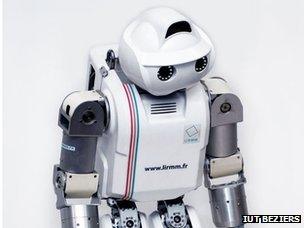Man and robot linked by brain scanner
- Published

The man-machine link was used to control a small humanoid robot
Robot avatars have got a step closer to being the real world doubles of those who are paralysed or have locked-in-syndrome.
Scientists have made a robot move on a human's behalf by monitoring thoughts about movement, reports New Scientist.
The man-machine link joined a man in a brain scanner in Israel and a robot wandering a laboratory in France.
The person controlling the robot could also see through the eyes of his electronic surrogate.
The researchers are now working on ways to make the man-machine link more sensitive and to let people speak via the robot.
Mirror test
The research project connected a robot to a man having his brain scanned using fMRI (Functional Magnetic Resonance Imaging). This monitors blood flowing through the brain and can spot when areas associated with certain actions, such as movement, are in use.
Using brain scanners is a step beyond current efforts to link up men and machines. Much recent work involved teleoperated robots in which humans manipulate controls, such as joysticks, to make a robot move.
By contrast, the scanning approach is more subtle and attempts to fool the human subject into thinking that they are embodied in the robot.

Eventually the small robot will be swapped for one the size of an average human
The experiment helping to prove the technology works linked up student Tirosh Shapira who was in a lab at Bar-Ilan University, Israel, with a small two-legged robot thousands of kilometres away at Beziers Technology Institute in France.
Prior to connecting the two, researchers made Mr Shapira think about different sorts of movements and developed software that could quickly spot his intention.
The result, <link> <caption>reported the magazine</caption> <url href="http://www.newscientist.com/article/mg21528725.900-robot-avatar-body-controlled-by-thought-alone.html" platform="highweb"/> </link> , was that he could control the robot in almost real time.
The illusion of embodiment was tested by surprising Mr Shapira with a mirror so he could see his robot self - a test that convinced him he was present in the French lab.
The next step for the research is to refine it to use a different type of scanning that can work using a skull cap rather than an fMRI machine that a person has to lie in. The robot used to represent a human is to be upgraded to a version that has a similar stature and gait to a real person.
The research is part of an international project called Virtual Embodiment and Robotic Re-Embodiment that aims to refine ways to link people and surrogates in both virtual environments and the real world.
Work is being done on medical applications of the technology but the researchers warned that it was a long way from being able to help anyone yet.
- Published11 May 2012
- Published10 May 2012
- Published9 September 2011
- Published29 July 2011